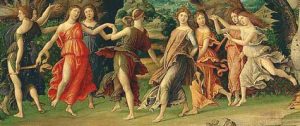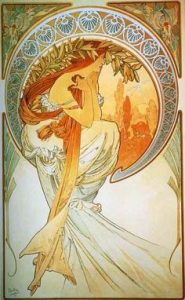The Muse
Calliope, Clio, Erato, & Euterpe: The Muses of Writing

Muses, part from Mantega’s Parnassus 1497
What does the Muse receive in return for her gifts of inspiration and creative energy?
She is analyzed, modified, and even distorted by artistic license. Cruelly, she is stripped of her essence and then immortalized, before finally becoming grandiose. And then, she is quietly discarded when the need and desire for her favors have waned.
So, why does she do it then? It isn’t her choice to become a Muse. Her essence demands it, her eccentricities, personality, and appearance dictate these things.

“In Greek mythology, the artist created works of beauty because of a Muse, who not only inspired but also demanded the creation of the work. But, there are two different conceptions of the artist’s relationship to the Muse. In the first, the artist is no more than an amanuensis who copies out what the Muse dictates to her. Artists often talk this way out of a sense of modesty: they tell us that they merely wrote down what a higher intelligence created. This version of the myth, however, disguises important features of human artistic creation. Most artists are not obedient copyists; they create only as a result of practice and hard work, and they suffer greatly for their art.
In the other conception, the Muse is a harsh task mistress who relentlessly drives the artist to create the beautiful, often to the point of madness. The Muse demands enormous sacrifices of the artist but is never satisfied with the results, and so artists live their lives in a sort of perpetual bondage to their Muse.
The copyist has the advantage of knowing what the finished product will look like; the servant of the Muse does not have this luxury. The servant must turn her inchoate sense of drive for beauty into a work of art, always with the risk that it will not please the Muse who goads her.
In this story, the Muse is the mythological externalization of the human drive to value and create works of value. Thus we might say metaphorically that transcendent human values are like Muses, and that there is a Muse of justice as well as one of truth.” (JM Balkin, Cultural Software: A Theory of Ideology)






